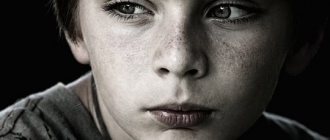Introduction
Anxiety disorders (AD) are one of the most common reasons for visiting doctors and are often encountered in the clinical practice of pediatricians and pediatric neurologists.
It should be noted that until now, some specialists in the process of monitoring children and adolescents with TD continue to use such formulations as “neurotic conditions”, “neurotic reactions”, “neurosis-like syndrome”, and often incorrectly use the concepts of “asthenia”, “neurasthenia” , "asthenic neurosis". The listed terms do not correspond to the definitions of TR in the classifications of recent years [1, 2], as well as to modern ideas about the nature of TR. According to epidemiological studies, the overall incidence of all TDs in children and adolescents varies from 9 to 32% and is characterized by an increase as children grow older [3]. In the majority of adult patients with emotional and affective disorders, the first symptoms manifested in childhood or adolescence, and these were manifestations of TD [4, 5]. Thus, the formation of the clinical picture of TR occurs gradually. However, in many children and adolescents, TR remains unidentified for a long time, which leads to a lack of specialized care and drug therapy, and subsequently, the chronicity of TR.
Let us dwell on the features of the manifestations of TD in children and adolescents. It should be noted that some patients may simultaneously experience symptoms of not one, but several forms of TR. In addition, TD can act as both an independent and concomitant condition in many diseases of the nervous system in children, including disorders of speech development and school skills, attention deficit hyperactivity disorder, primary headaches (especially tension headaches), epilepsy, consequences perinatal lesions of the nervous system, traumatic brain injuries, neuroinfections, autism spectrum disorder, etc.
TR is a group of syndromes of emotional disorders that are characterized by intense and prolonged anxiety, subjective feelings of anxiety, tension, gloomy forebodings, the experience of damage, as well as the appearance of unusually strong fear - irrational and not consistent with the content of the situations or objects that cause it [4, 6–9] .
How to determine that a child is anxious?
In general, this condition is not a diagnosis. The specialist most likely will not prescribe treatment until the situation worsens. However, if no measures are taken, the consequences can be disastrous.
If parents notice that the child is anxious, cannot concentrate, and needs parental protection, it is advisable to consult a doctor for recommendations.
How can we determine that this is not just situational nervousness or fear, but a serious problem that requires intervention?
There are several obvious signs of an anxious child:
- Hysterical behavior when parting with loved ones. At first it may seem that the baby is reacting painfully solely to parting with his mother, but this is not so. An anxious child has a hard time being separated from anyone he knows. A clear example of this behavior is visiting kindergarten at the first stage.
- The child constantly clings to one of the parents and reacts sharply to attempts to separate him. At first glance, this is normal, because this is how children feel protected. But there is also a downside. Without physical contact with a loved one, the baby develops a feeling of anxiety.
- Refusal to go to an educational institution. Some parents think that this is due to the fact that children simply do not like studying, the staff or the regime at school or kindergarten. But the cause may be anxiety, which, by the way, greatly inhibits the learning process.
- Sleep disorders that are expressed by various symptoms. The child has nightmares and cannot fall asleep for a long time. In advanced cases, the baby experiences urinary incontinence. Most often, the reasons lie precisely in the psycho-emotional state, which requires immediate intervention.
- Crying even over small things. In such cases, it is strictly forbidden to call the child a crybaby or other offensive words. The point here is increased anxiety, and threats and humiliation cannot eliminate the problem.
- Psychosomatic reasons. In some cases, such symptoms are a sign of anxiety in the child. This could be abdominal pain, lack of air, loss of consciousness, and more. They are most pronounced when being close to the object of alarm.
The degree of severity is determined by the number and intensity of manifestations. If only one of the listed signs appears occasionally, there are no serious concerns, and with the support of the family, the child will cope with anxiety on his own. If concern is manifested by several symptoms, they are intense and long-lasting, specialist intervention is necessary.
Diagnosis and classification of TR
The first task that must be solved when diagnosing TD is to distinguish anxiety as a normal and proactive response to threatening or stressful influences from the manifestation of TD. Anxiety performs an adaptive signaling function (“signal alarm”) to prepare at the organism level to encounter danger and select a reaction to it: “attack, fight” or “escape, avoidance.” Normally, manifestations of anxiety are short-term (transient) in nature and are well under the control of the individual.
Manifestations of anxiety acquire clinical significance in cases where:
their severity and duration become significant;
symptoms occur in the absence of stress factors;
symptoms disrupt the physical (somatic) and socio-psychological functioning and adaptation of the individual.
The presence of TD is indicated by the fact that the child experiences anxiety more often (for example, on most days of the month and for several months) and experiences it more intensely compared to peers. Excessive anxiety leads to significant disruptions and limitations in a child's life: it is difficult for him to participate in normal activities for his age, attend school, cope with daily school and homework, socialize and make friends, and attend leisure activities and sports clubs. Table 1 presents the differences between anxiety and fears that are acceptable during the individual development of children and their pathological manifestations.
All forms of TR are accompanied by changes at four levels.
Emotions: fear, apprehension, embarrassment, shame, helplessness, guilt, sadness, anger.
Thoughts: about possible harm/danger/damage that cannot be dealt with on your own, negative thoughts of an obsessive nature.
Behavior: choice of avoidance strategy (active avoidance of specific situations, places or stimuli, its erased manifestations in the form of uncertainty, indecision, desire for loneliness) and the use of so-called “safety techniques” (recourse to objects and situations that do not allow the development of extremely pronounced fear, with the formation of “rituals”). There may be repeated appeals to adults for comfort and support, and excessive apologies to other people.
Sensations (physiological level): due to an imbalance of autonomic regulation - rapid heartbeat, rapid breathing, increased sweating, headache, dizziness, feeling of lack of air and approaching fainting, cramps and pain in the abdomen, nausea, vomiting, diarrhea, paresthesia (tingling, numbness) in the face or hands, a feeling of unsteadiness or weakness in the legs, a tendency to tremble or tremors, sleep disturbances (difficulty falling asleep, restless sleep, nightmares, insomnia).
One of the key signs of TD is fear, but it should not be equated with anxiety. Anxiety is a combination of emotions, and fear is one of the emotions. Fear, as a normal emotion, is a reaction to an external threat and is adaptive in nature; it warns the individual that the situation may be physically or psychologically dangerous. Fears are characterized by normal age-related evolution (Table 2). Moreover, they can be of a realistic nature (in relation to specific animals, bodily injuries, natural phenomena) and unrealistic, irrational (fear of the dark, mice, monsters, disasters).
Thus, fears as an isolated phenomenon should not be considered as a sign of illness. The help of a specialist is necessary in cases where fears lead to obvious social restrictions: refusal to go outside for fear of meeting a dog or experiencing a panic attack, refusal to attend school.
In the clinical picture of TD, fears are characterized by a stable and non-adaptive nature [9]:
excessive intensity that does not correspond to the situation (quantitative aspect);
unusual content and unusualness of objects that cause fear (qualitative aspect);
inadequate response to the situation;
chronic fear;
inability to reduce or overcome fear;
significant restrictions in everyday life.
Ultimately, manifestations of TD affect all areas of life, significantly worsening the child’s general well-being, school performance, family relationships and friendly contacts, and social activity.
TR include [1, 2]:
TD associated with separation in childhood (separation TD);
selective mutism;
phobic TD of childhood (specific phobias);
social TD of childhood;
generalized TR of childhood;
panic disorder;
agoraphobia.
Two other disorders that were previously classified as TD are obsessive-compulsive disorder and post-traumatic stress disorder. In modern classifications [1, 2], they are considered as separate nosological forms.
Separation TR
Some children experience fear and painful apprehension because, with a real or imagined threat of separation, something bad will happen to them or their loved ones (most often to their parents). The child strives to avoid separation, experiences excessive fear, sadness, and withdraws into himself. On the other hand, there are attacks of rage, crying with the desire to keep a loved one nearby, clinging to him and a categorical refusal to part. The child refuses to be in situations where he may find himself without loved ones: staying away from home at night, visiting friends or relatives, being at home alone, or going to school without parents. After suffering separation from loved ones, children remain depressed, withdrawn and apathetic. They refuse to be alone in the room and ask parents to be present or available.
Separation anxiety usually goes away as children grow up, go to school, and gain confidence. However, for some children, their reaction to actual or expected separation continues to be excessive, which can sometimes continue into the first 1–2 years of school and even beyond. Manifestations of separation anxiety disorder can impede or limit the child’s normal activity, lead to deterioration in school attendance and academic performance, and isolation from peers because he avoids participating in school outings, excursions, games, overnight trips without parents, or other activities. Such children differ from their peers in their lack of independence.
Separation-related TD is most common in children under 12 years of age and decreases in incidence during adolescence. This type of TD affects about 4% of children and 1.5% of adolescents [1, 3, 4]. However, separation anxiety can persist into adulthood.
The occurrence of separation TD reaches its peak in several age periods: upon entering kindergarten, in elementary school at the age of 7 to 9 years, upon entering middle and high school. Boys and girls suffer from separation TD equally often. During adolescence, separation anxiety either persists or arises for the first time (after a stressful event, such as parental divorce, loss of a loved one, moving to a new school, moving).
Selective mutism
Selective mutism —
one of the forms of TD in children, which in some cases has to be differentiated with alalia (developmental dysphasia). Manifests at the age of 2–5 years. The prevalence in the pediatric population is less than 1% [1, 10]. More often, selective mutism occurs in families with bilingualism, when moving to a new place of residence with a different language environment. It occurs during the period of active speech development or upon entering kindergarten, in preparation for school. Selective mutism limits communication capabilities, can distort the child’s mental development, and complicates his social adaptation.
The child stops talking to everyone except a small circle of familiar people. This continues for a long time, up to several months. Despite the preservation of speech, the child consciously refuses verbal communication (and sometimes any communication) in situations that are psychologically traumatic for him (both in a group of children and among adults). At the same time, he not only refuses to speak - he is unable to do so because of the feeling that his speech seems to freeze in the larynx. Gradually, the child learns to anticipate situations that provoke mutism and tries to avoid them.
An important feature is that the majority of patients with selective mutism have manifestations of social TD, and at an early age - separation TD [10]. A number of patients experience a combination of selective mutism with disorders such as speech development disorders, enuresis, encopresis, delayed motor development, autism, and in rare cases, attention deficit hyperactivity disorder. Selective mutism is not currently considered within the framework of oppositional behavior, but oppositional reactions may occur if the child is forced to speak.
Although the first symptoms of selective mutism appear before the age of 5, they may become most noticeable once school starts. Selective mutism causes significant difficulties in children's lives, affecting their academic performance, preventing them from seeking help from teachers and other adults, and preventing them from enjoying social interactions and participating in daily activities with their peers. In older children and adolescents, difficulties in communicating with peers often increase, which serves as a prerequisite for the formation of social and generalized TD or depression.
Specific phobias
Fears are common and expected in childhood, but for some children and adolescents, fears become intense over time and develop into phobias. A phobia is a strong fear that is disproportionate to a specific object or situation, extremely severe anxiety in the absence of immediate danger. Intense fear of certain situations and objects is accompanied by an avoidance response due to the belief that they are dangerous and will cause harm/injury. The most common pathological fears in children are caused by: animals (dogs and birds), insects and spiders, darkness, loud noises (especially those associated with natural phenomena), clowns, people in masks or unusual appearance, injections, diseases, the sight of blood.
Specific phobias manifest from early age to 10 years; they affect 6–9% of children and adolescents, more often girls than boys (in a ratio of 2:1) [1, 3, 4].
Some patients develop a phobia after exposure to a traumatic or frightening event, while others develop fears after observing other people's anxious reactions. Thus, a younger brother often begins to be afraid of a spider if he witnesses how the older brother runs away from the spider in fear and screaming. Phobias are different from ordinary childhood fears and rarely go away on their own. Often, phobias do not decrease, despite explanations and assurances of safety from adults. As a result, the child avoids frightening places or objects, forces parents to check if they are nearby (for example, before going to bed he wants to make sure that there are no spiders in the room), requires parents to stay nearby.
Children avoid parks, playgrounds, recreation areas and other places where there may be insects, refuse walks and nature excursions if they may encounter what they consider dangerous animals (for example, dogs), and protest against visiting medical institutions or doctors. , in particular dentists. As children grow older, phobias do not disappear, but change in content. But teenagers are more likely than younger children to recognize that their fear is disproportionate to the actual danger posed by a particular object or situation. In addition, unlike young children, who have less control over themselves in everyday life, adolescents can independently avoid certain situations and direct confrontations with their fears.
School-age children may experience a fear of school, which manifests itself in the same way as a phobia, and they refuse to attend. In this regard, the term “school phobia” appeared, although as such there is no diagnosis or form of TD with this name. The range of manifestations of school fears can vary from minor complaints about the need to attend classes to hysterics and refusal to go to school in young children, and in adolescents - to frequent absences from classes with subsequent exclusion from school. Children may be afraid of school for many reasons, for example, because they have to be left without parents (as happens with separation anxiety disorder), because of fear of contact with germs (with obsessive-compulsive disorder), because of fear of interactions with peers and teachers (with social TD). In these cases, the child or teenager is actually afraid not of the school itself, but of the events that could happen to them there. Because of this, the term “school phobia” is not accurate.
On the other hand, the causes of school phobia may be difficulties in adapting to the classroom, fear of bad grades, fear of making a mistake or getting reprimanded by the teacher, conflicts with classmates, fear of physical aggression on their part. Some parents, without noticing it themselves, instill in their children a fear of school by overly dramatizing learning problems; they deprive the child of the opportunity to show initiative and independence - they do homework for him or strictly control them, resenting every clumsily written letter. As a result, the child is not so much afraid of school as he is afraid of not meeting the high expectations of his parents. Any of these problems can make a child's school life unbearable. In such cases, not only parents, but also teachers should help him cope with this situation.
Social TR
Social TD manifests itself as intense, accompanied by an avoidance reaction, fear of situations related to social contacts, any forms of behavior in public places, when the child/adolescent thinks that he will do something wrong and will cause a negative assessment and ridicule from others. Such situations include public speaking, answering lessons in front of the class, taking exams, meeting new peers, parties, playing sports, conversations with elders or leaders, including teachers at school, when the child is the center of attention. Some children are only afraid of speaking or performing in public, while others are afraid and avoid a wider range of social situations.
Social TD is observed in 2–7% of children and adolescents, equally often in boys and girls, manifests itself at 7–13 years of age, more often in early adolescence, but can also manifest itself in elementary school [1, 3, 4]. Social TD appears suddenly after suffering stress or develops gradually over time.
Problems associated with social TD: passivity in class (cannot ask questions and answer clearly, read aloud, write on the board, express and defend opinions), poor academic performance, low self-esteem and uncertainty in social situations, difficulties in establishing and maintaining friendships, refusal to go to group events (birthdays, parties). The child cannot eat in the presence of others or use a public toilet. Children become overly shy and often expect things to go wrong when they are surrounded by other children. However, they may be concerned that others are watching them and discussing their behavior.
Social TD goes unnoticed by teachers and parents for a long time, because such children do not want to remain in the public eye and try to be invisible. Therefore, they are only noticed when they start skipping school or getting bad grades.
Adolescents and young adults with social TD are even more self-focused and have low self-esteem. When they start working, due to extreme fear or embarrassment, they may feel awkward when making acquaintances, interacting with colleagues, or interviewing management. They have an increased risk of depression, alcohol or drug use.
Generalized TR
Generalized TD is manifested by excessive anxiety with anticipation of an unfavorable development of a variety of events and circumstances related to the family, the state of one’s own health and those of loved ones, financial situation, friends, school, as well as everyday affairs. A child in such a situation is characterized by a constant search for support from parents and other people in connection with his own fears, avoidance of everything new, especially negative news, uncertain situations, and the possibility of making a mistake. It is also typical to have somatic symptoms, insomnia, irritability, muscle tension, and difficulty concentrating during anxiety.
The manifestation of generalized TD occurs at the age of 10–12 years, it is observed in approximately 1% of adolescents, 2 times more often among girls than among boys [1, 3, 4]. If left untreated, the disease does not disappear until adulthood and leads to a significant deterioration in quality of life.
Patients with generalized TD experience persistent irrational and uncontrollable worry about various aspects of daily life and future events, including minor issues. Young children tend to worry about simple and immediate issues, such as family safety, love and affection from loved ones, and school success. Adolescents show concerns about the health and safety of themselves and their families, academic performance, friendships and relationships with other people, their own punctuality, their future, relationships between parents or family stability, world events (related to nature, climate, environment). environment, politics, crime), etc.
Since patients with generalized TD experience severe somatic symptoms of anxiety, fatigue, irritability, impaired concentration, muscle tension and sleep disturbances, exaggerated, physically debilitating constant and uncontrollable anxiety, this has an extremely negative impact on the quality of life of the child and his family. The behavior of a child in this state is characterized by excessive time spent on completing homework, repeated tedious thinking about situations, repeated and unreasonable compilation of lists, frequent checks (of the progress of current affairs, relationships, health status with the identification of possible illnesses), procrastination in completing tasks, painful focusing of interests on subject of concern. This creates a tense environment around the child, worsens friendships and family relationships due to constant fears and endless requests for support.
The negative impact of ongoing constant worry becomes more obvious the older the child gets. Parents, teachers, and other adults notice that the teenager is different from his peers, spends a lot of time doing tasks ineffectively, appears stressed and exhausted, and refuses to participate in recreational activities or spend time with friends out of fear of failure. Over time, constant anxiety and detachment from friends and common activities with them increase the feeling of one’s own inferiority and predispose to depression.
Panic disorder, agoraphobia
Panic disorder - repeated and developing unexpectedly, without connection with any reason or situation, attacks of extreme anxiety (panic), which quickly reach a peak, are accompanied by threatening, in the patient's opinion, somatic symptoms (chill-like trembling, shortness of breath, palpitations, pain or discomfort in the chest, dizziness, nausea, profuse sweating, numbness, paresthesia, feeling of powerlessness), fear of death or madness. A panic attack is a sudden outburst of intense fear and discomfort that peaks and subsides within a few minutes. Following a panic attack for at least one month, the patient experiences anxiety about the occurrence of new attacks, he is afraid that something irreparable will happen to him due to a panic attack (losing control of himself, going crazy, dying), changing his behavior, to avoid a repeat panic attack (for example, avoiding physical activity).
In addition to panic disorder, many children and adolescents may develop agoraphobia, although the two conditions can exist independently of each other. Agoraphobia is characterized by intense anxiety and fear of real or perceived situations that may trigger a panic attack, and avoidance of such situations. Children are frightened by being in places from which it is difficult to get out quickly: public transport, open spaces (markets, bridges, parking lots), closed spaces (shops, cinemas, theatres), queues or crowds of people, they are afraid of being alone outside the home. Fear is associated with places from which it is difficult to escape and where it is impossible to get quick help. Therefore, children avoid as much as possible places and situations in which panic attacks have previously occurred; indoors they try to take seats near the aisle or closer to the exit; they try to maintain contact with security staff; they carry medications with them; they wear loose clothing that does not restrict movement; and they avoid physical abuse. exercise, any activity that activates the body.
Most often, panic disorder and agoraphobia manifest in young adulthood, but sometimes at 13–15 years of age. They affect approximately 2% of adolescents, girls are 2 times more likely than boys [1, 3, 4].
Problems associated with panic disorder and agoraphobia include low self-esteem, decreased independence, poor performance and absenteeism at school, refusal to travel and travel, difficulties in relationships with peers and family members, fear of separation from parents, transitions from home to school, disorders sleep, risk of depression and alcohol or drug use.
Pathogenetic mechanisms of TR
Previously, the term “childhood neurosis” was used in relation to TD. However, this concept is not entirely correct, since it means that the child’s emotional difficulties stem from unconscious internal psychological conflicts [7]. According to modern concepts, the development of TD occurs through the interaction of biological, psychological and environmental factors [8]. Risk factors include parental anxiety, child temperament with a tendency to withdraw, traumatic/negative/stressful life events, and parenting style [8].
Since various childhood TDs often occur in familial cases, much attention is paid to the study of hereditary predisposition and genetic mechanisms of TD. Neurobiological mechanisms (heredity and early brain damage caused by perinatal pathology) can lead to dysfunction of a number of brain structures and neurotransmitter systems [4]. The GABAergic, noradrenergic and serotonergic systems are considered key in the pathophysiology of TR and the mechanisms of action of anxiolytic drugs. It is assumed that further study of the neurobiological mechanisms of TD, including the use of functional neuroimaging methods, will make it possible to clarify the fundamental mechanisms of anxiety, the role of dysfunction of various brain regions, and to substantiate rational approaches to the treatment of TD.
When assessing environmental factors, it should be taken into account that to ensure the vital functions of a child’s body, many nutrients are needed, among which vitamins, macro- and microelements play an important role. Increased anxiety, irritability, emotional lability and fatigue can signal the body about metabolic disorders due to a deficiency of vitamins (especially group B) and minerals (in particular, magnesium, zinc). It is known that an increased need for vitamins and minerals at the usual level of their intake occurs in children during periods of the most intensive growth, under the influence of significant physical or psycho-emotional stress, and various stressful situations. The need for these nutrients also increases significantly in children with TD. A deficiency of vitamins, macro- and microelements in the body can be associated not only with high costs, but also with their low content in consumed food products and water. Therefore, in the process of examining patients with TR, attention should be paid to the completeness of their nutrition, which is determined not only by the energy value of food and the balance of the diet in proteins, fats and carbohydrates, but also by the provision of vitamins, macro- and microelements.
Why does it happen?
The main causes of anxiety in a child under 6 years of age are difficult relationships with parents. This is especially true for boys. The degree of anxiety in parents is largely reflected in the similar state of the child. The use of an authoritarian parenting style, excessive demands on the child, or comparing him with others significantly increases anxiety. Anxiety often occurs as a result of neuroses and other mental disorders.
The main reasons for this condition include:
- lack of feeling of safety in the child;
- pushing away the baby by adults, their hostility;
- unfavorable family environment;
- poor financial resources of the family;
- discrepancy between the parents’ requirements and the child’s real capabilities;
- inadequate demands of adults towards the baby;
- increased levels of anxiety in parents;
- adults presenting demands that contradict each other;
- parents are unable to maintain consistency in raising a child;
- authoritarian parenting;
- excessive emotionality of parents;
- constant comparison of the child with peers;
- the desire of parents to meet generally accepted standards.
Therapy for TR
Treatment of TD in children and adolescents is based on an integrated approach using methods of psychotherapy (rational, cognitive-behavioral, family, play, etc.) and pharmacotherapy. An important role belongs to parents who, following the recommendations of a specialist, help their child cope with anxiety. When coping skills and courageous behavior are practiced and encouraged at home, children and adolescents learn to face their fears, take smart risks, and gain confidence in their own abilities.
In pharmacotherapy, drugs of several groups are used, including non-benzodiazepine tranquilizers (hydroxyzine), tranquilonotropics (aminophenylbutyric acid hydrochloride), drugs with sedative and vegetative-stabilizing effects (affinity-purified antibodies to the brain-specific protein S-100), selective serotonin reuptake inhibitors (fluvoxamine, sertraline), mild antipsychotic drugs (alimemazine), herbal medicines. It should be noted that there is a need for long-term medical supervision and long-term therapy.
For children and adolescents with various forms of TR, complex medications may be recommended, including neurometabolic agents, vitamins, macro- and microelements. Such a drug is “KidZ syrup with lemon balm and mint,” which is prescribed in courses of 2 weeks. in the following doses:
child from 3 to 7 years old - 5 ml 2 times a day;
child from 7 to 11 years old - 5 ml 3 times a day;
for a child over 11 years old - 10 ml 2 times a day.
The composition of the drug “KidZ syrup with lemon balm and mint” includes useful and safe components (B vitamins, amino acids, magnesium, zinc and plant extracts) that normalize the functioning of the nervous system, restoring the natural balance between the processes of excitation and inhibition:
lemon balm and mint in the form of extracts help eliminate nervous tension;
choline (a precursor to the neurotransmitter acetylcholine) is involved in the formation of components of brain tissue, helps improve memory and performance;
glycine has a beneficial effect on motor skills and speech, helps reduce psycho-emotional stress, aggressiveness, and conflict;
lysine protects brain cells from oxygen starvation, slows down excitation processes;
vitamin B1 (thiamine) ensures metabolic processes in the central nervous system (CNS), affects the functions of neurotransmitters (acetylcholine, GABA), the processes of nerve impulse conduction;
vitamin B3 (niacin, nicotinamide) ensures the occurrence of redox processes in the body and the normal functioning of the central nervous system;
vitamin B6 (pyridoxine) is involved in the biosynthesis of neurotransmitters (GABA, serotonin, catecholamines, etc.);
magnesium is a central element that maintains the balance of excitation and inhibition processes in the central nervous system. Magnesium is necessary to stabilize the activity of excitatory (glutamate) receptors. It is a cofactor of adenylate cyclases involved in signal transmission from dopamine, serotonin and adrenaline receptors to control intracellular cascades, as well as a cofactor of catechol-O-methyltransferase, which inactivates excess monoamine neurotransmitters;
magnesium and vitamin B6, when administered together, help improve behavior, reduce anxiety and aggressiveness, and increase concentration;
zinc is involved in ensuring mental processes, since it is part of all known classes of enzymes and is involved in the metabolism of proteins, fats, carbohydrates and nucleic acids. Zinc is necessary for the processes of neuroontogenesis, is part of brain metalloproteins that have neuroprotective properties, and is involved in the mechanisms of learning and memory.
Why is this condition dangerous in children?
An anxious child may develop the following problems:
- Deterioration in academic performance. It is worth noting that some children, on the contrary, begin to study better, fearing anger or punishment from their parents.
- Social exclusion. It is expressed by the fact that the child withdraws into himself and stops communicating with peers and people around him, with the exception of his parents. In the future, he may never learn to communicate, will not learn basic social skills, and will become an outcast.
- Every new person in the environment, a conversation with an unfamiliar person causes anxiety in the child.
- Fear of making a mistake. This is a serious problem, which over time will be reflected not only in the child’s indecisiveness when taking an important step, but even in small things. He will most likely get used to always retreating in everything and will grow up indecisive. If such a character trait is excusable for girls, then the young man will face many problems in life.
- Inappropriate behavior. Anxious children, growing up, often become so-called freaks. Even when they outgrow childhood fears, they strive to stand out in any way or, conversely, to distance themselves from society.
How to play with anxious children?
When starting classes with an anxious child, you must adhere to the following rules:
- A new game is introduced gradually, first explaining its rules. Then they clearly show how other children play it. A child is attracted only if he wants to become a participant.
- It is recommended to avoid the competitive component of competitions.
- When introducing a new game, you should remember that the child should not feel in danger from meeting the unknown. It is advisable to study on already familiar material. You can partially use the rules of a previously well-mastered game.
- Blindfolded activities are introduced only after careful preparatory work and with the consent of the child.
Comprehensive behavior correction, attentive attitude of loved ones, a welcoming atmosphere in the family - all this will allow you to achieve positive dynamics and raise a self-confident child.
How does the condition manifest itself in preschool age?
Constant worry can develop in a child at any stage of life. Anxious children of preschool age constitute a large group that requires mandatory intervention from a specialist in the early stages.
Thus, children aged one to three years often experience nightmares. At two years old, the child reacts sharply to unexpected sounds, experiences fear of loneliness and pain, for example, reacts violently and for a long time to medical workers.
From three to five years old, children develop a massive fear of the dark, enclosed spaces or loneliness. One of the main causes of panic in children aged five to seven years is the fear of death.
Recommendations for parents of anxious children
Experts advise taking into account the following recommendations:
- Do not make excessive demands on your child.
- Show your love for your baby as often as possible.
- Praise your child publicly.
- Do not say words that degrade the dignity of children.
- Criticize less.
- Don’t force them to apologize, but ask them to explain the reason for the offense.
- Spend more time together.
- Hug and hold your child's hand often.
- Take an interest in the baby’s life, his opinions and feelings.
- Be unanimous and consistent in raising your children.
- Offer to help your child, but do not solve all the problems for him.
- Share your childhood fears and difficult situations.
Increased self-esteem
The work of a psychologist with an anxious child includes three components:
- Increasing your child's self-esteem.
- Developing skills to manage your emotional state.
- Exercises to reduce muscle tone.
It is quite natural that it is impossible to quickly raise a child’s self-esteem. It is important to carry out appropriate activities daily. Address the baby by name, praise him for the slightest achievements alone and in the presence of other children. At the same time, approval must be sincere, since every child feels and reacts painfully to falsehood. It is imperative to say why he is being encouraged.
Let's look at the remaining elements in more detail.
Decreased muscle tone
For restless guys, relaxation exercises are extremely useful. The list of recommendations for parents of anxious children includes massage sessions, yoga, and breathing exercises.
A great way to relieve increased anxiety in a child is to paint their face with unnecessary lipsticks or special paints. You can arrange a kind of masquerade or dress-up show. To do this, masks, costumes and other accessories are made together with children. Such an impromptu performance will relax the baby and bring a lot of pleasure.
Organizing the lives of anxious children
For such guys, adherence to the regime is of great importance. They are not very fond of hygienic procedures, so it is important that bathing in the bath brings them pleasure. Let it be foam, toys, that is, what they like. It is better to hold off on health procedures and mastering swimming. Anxious children do not like to change clothes, so it is better to buy clothes for them that are comfortable, that are easy to take off and put on.
It is difficult to feed children with anxiety syndrome, so there is no need to prepare multi-component meals for them, let it be something simple and healthy.
It is difficult for an anxious child to interact in a group, so it is necessary to create conditions for him under which he can be among children. There is no need to force the baby, he should be gently guided.
Sometimes it is very difficult for parents to find a common language with their child, but if you sensitively respond to his feelings and requests, establish warm relationships, then over time he will begin to change for the better.
Prevention of anxiety
If parents want their child to grow up balanced, first of all it is necessary to create a favorable psychological environment in the family that promotes harmonious personal development. If you establish a trusting relationship with your baby from an early age, then the development of anxiety in him can be avoided.
Corrective work with anxious children, as well as preventive measures, include discussion of the child’s emerging problems, close communication, spending time together, walks, picnics, etc. Parents and children are brought together by a relaxed atmosphere, joint creativity, which allows them to relax.









